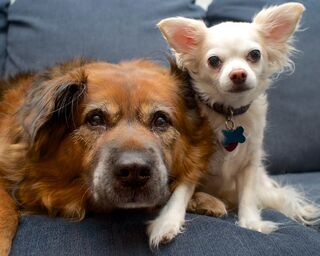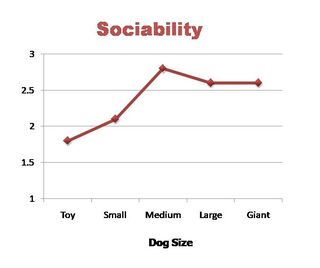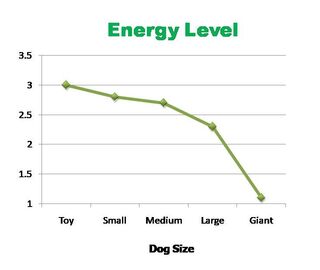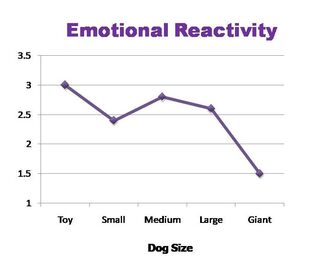Personality
Are the Behaviors of Large and Small Dogs Really Different?
A new analysis finds that big and small dogs differ in some of their behaviors.
Posted July 26, 2022 Reviewed by Abigail Fagan
Key points
- There are many contradictory stereotypes claiming to describe how canine size affects dog behaviors.
- Analysis of behavioral data from 196 dog experts describing 133 dog breeds was conducted and tested against dog size.
- Dog size was found to be significantly related to sociability, activity level and emotional reactivity.

If you believe the statements from various websites on the Internet, there are huge differences in the behavior of dogs based upon their size. You will find statements like: "Big dogs are lovable cuddly bears", "Small dogs are hyper and nervous", "Big dogs are easier to train than most small dogs", "Large dogs are more apt to be aggressive and dominant", "Small dogs are snobbish and yappy" and so forth. The statements made about canine behaviors and their relationships to dog size are often contradictory, although they are always expressed with great confidence. Unfortunately these assertions are almost never accompanied by references to scientific data.
I recently received an email query from a colleague which read in part, "The claims that big and small dogs are behaviorally different often become an issue when I am talking with clients in my training classes. I was wondering if you knew of any real data that bears on the issue."
A Useful Data Set
It just so happens that I still have a databank on the personality traits of 133 individual dog breeds which I collected for my book Why Does My Dog Act That Way. The data was based on ratings by 96 dog experts, each of which was willing to contribute several hours to rank dog breeds on five different behavioral dimensions.
Dominance/Territoriality: This is a measure of how assertive and possessive a dog is. This is also the trait that is most closely associated with aggression.
Sociability: This refers to how friendly a dog is, and how much a dog seeks out companionship. In human personality terms this is usually labeled agreeableness.
Emotional Reactivity: This is a measure of how quickly the dog's mood may change, and how fluctuating his emotional state may be. In humans the aspect of personality associated with this trait is called neuroticism which is usually contrasted with its opposite pole, stability.
Energy Level: This is a composite measure that looks at the dog's activity level and includes a measure of vigor, which is the amount of force and energy the dog brings to common activities.
Intelligence/Learning Ability: This is a measure of how easily a dog learns and solves problems. In humans the aspect of personality associated with this trait is called openness.
I had never before analyzed these data in terms of dog size, so I went back to the data bank and re-coded the information for each breed using the five size categories for dog breeds employed by the American Kennel Club: Giant Breeds range 75-120+ pounds (34-55+ kg); Large Breeds, 55-75 pounds (25-34 kg); Medium Breeds, 35-55 pounds (16-25 kg); Small Breeds, 7-35 pounds (4-16 kg); and Toy Breeds, 2-9 pounds (1-4 kg).
For those who would like more computational information, the data was then statistically analyzed using a one-way analysis of variance for each behavior dimension.
The Effect of Canine Size on Canine Behavior
It turns out that three out of the five measured behavioral dimensions had statistically significant relationships with dog size. The two dimensions which were not significantly related to size were Dominance/Territoriality and Intelligence/Learning Ability. Since there were no reliable differences associated with dog size for these two dimensions, no further analysis or discussion of these seems to be needed for the moment.
Sociability

Sociability, or friendliness, was significantly related to size. As the graph shows, toy and small dogs are lower in sociability. Medium, large and giant dogs all are higher in sociability than their smaller cousins, however there is not much difference among the medium and larger breeds, all of which score as being generally agreeable. This suggests that the smaller breeds are less apt to seek out the affection of people and to be more unapproachable than larger dogs.
Energy Level

Perhaps the most frequently encountered stereotype relating dog size to behavior is that smaller dogs tend are supposed to have higher energy levels while larger dogs have the lowest energy (usually describing them as "laid-back"). This particular stereotype appears to be borne out by the data with the smallest dogs having the highest energy level. These data show that there is a gradual reduction in energy level as dog size increases, culminating with a very low energy level for the giant dog sizes. This suggests the smaller dogs are more likely to be careening off of the walls while larger dogs are more apt to be imitating a floor carpet.
Emotional Reactivity

The final dimension that is significantly related to size is Emotional Reactivity. Here we see that the smallest dogs are the most emotionally reactive and the giant dogs are the least. The dogs in the middle range of size all are about equal, with moderate scores on this dimension. This is interesting because emotional reactivity has been related to the personality dimensions of neuroticism and stability in humans. So this data set suggests that extremely small dogs will be the most neurotic and the extremely large dogs will be exceedingly stable. Except for the extremes, dogs in the broad middle range of sizes will have a medium range of emotional reactivity.
So Does Dog Size Really Matter?
So what can we conclude from this data set? If we combine the data from the three behavioral dimensions where size makes a difference we can conclude that the smallest dog breeds are apt to be highly energetic, a bit standoffish when it comes to socializing with people and dogs, and very emotionally reactive to events occurring in their environment.
Contrast this with the largest dogs, the so-called giant breeds. These dogs will be highly sociable, relatively calm, and not particularly reactive in terms of mood swings.
Overall analysis of this particular data set suggests that in dogs, size matters when it comes to their temperament and personality. These effects seem to be most notable for the extremes of size, when we are comparing the smallest dogs to the largest dogs. In the middle range, you would be better off using a dog's breed as a predictor of its behavior, since that appears to be a stronger indicator than size alone.
Copyright SC Psychological Enterprises Ltd.
References
Coren, S. (2006). Why does my dog act that way? A complete guide to your dog’s personality. New York: Free Press




